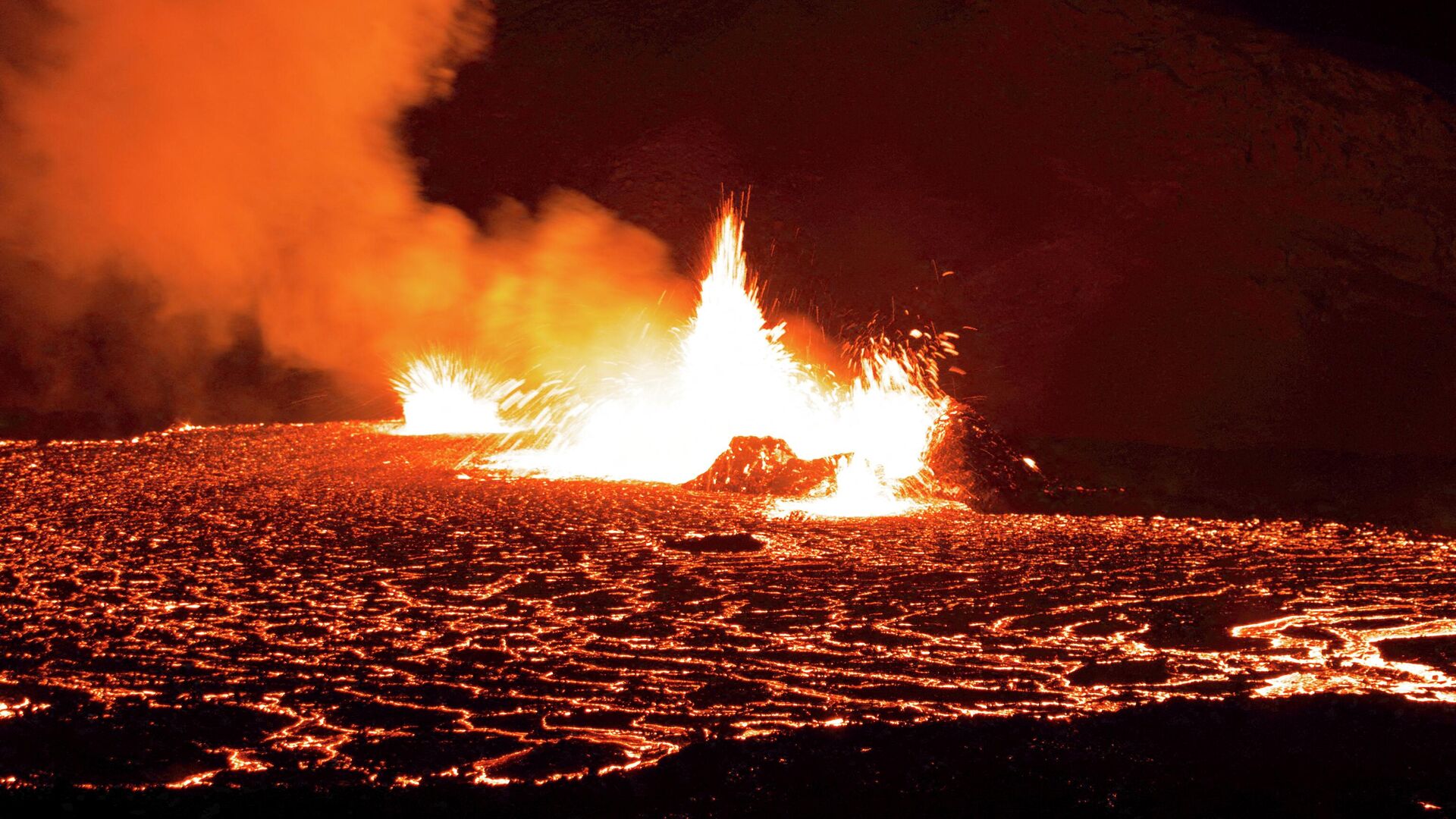https://sputnikglobe.com/20220919/iceland-volcano-eruptions-scientists-closer-to-figuring-out-fundamental-facts-1100960300.html
Iceland Volcano Eruptions: Scientists Closer to ‘Figuring Out’ Fundamental Facts
Iceland Volcano Eruptions: Scientists Closer to ‘Figuring Out’ Fundamental Facts
Sputnik International
Iceland has more than 30 volcanoes, both extinct and active. The 1784 eruption of Laki Volcano caused a famine that wiped out about a quarter of Iceland's... 19.09.2022, Sputnik International
2022-09-19T12:23+0000
2022-09-19T12:23+0000
2022-09-19T12:23+0000
science & tech
iceland
volcano
eruption
scientists
study
https://cdn1.img.sputnikglobe.com/img/07e6/09/13/1100953985_0:160:3073:1888_1920x0_80_0_0_c4aff2581fffbf564654fb8084746e44.jpg
Finding out fundamental facts about volcano eruptions remains a hard nut to crack for scientists from all over the world. Matthew Jackson from the University of California claims that he and his collaborators “have gotten close to figuring out” how volcanoes in Iceland work.In their study, published in the journal Nature, the scientific team focused on what they observed during the volcanic eruption of Fagradalsfjall Mountain on Reykjanes Peninsula, southwest of Island, in March 2021.Remarkably, this was the first time that a volcano has erupted in the area in 800 years, and Jackson was understandably happy to seize the opportunity and witness the eruption.He explained that he and his colleagues managed to obtain lava samples after the Fagradalsfjall volcano stopped erupting, something that helped Jackson shed more light on a number of specific issues. They in particular pertain to “how deep in the mantle the magma originated” and “what was happening in [a volcano’s] reservoir both before and during the eruption.”The scientists also said they had managed to witness “rapid” and “extreme” changes in magma composition inside the volcano, which they said “have never before been observed in near real-time.”Jackson, for his part, remained upbeat about the discovery, noting that when he goes out “to sample an old lava flow, it’ll always be on my mind: This might not be the complete story of the eruption.”
https://sputnikglobe.com/20220130/mysterious-acoustic-gravity-waves-caused-by-tonga-volcano-eruption-baffle-scientists---1092623821.html
iceland
Sputnik International
feedback@sputniknews.com
+74956456601
MIA „Rossiya Segodnya“
2022
Oleg Burunov
https://cdn1.img.sputnikglobe.com/img/07e4/09/0b/1080424846_0:0:2048:2048_100x100_80_0_0_3d7b461f8a98586fa3fe739930816aea.jpg
Oleg Burunov
https://cdn1.img.sputnikglobe.com/img/07e4/09/0b/1080424846_0:0:2048:2048_100x100_80_0_0_3d7b461f8a98586fa3fe739930816aea.jpg
News
en_EN
Sputnik International
feedback@sputniknews.com
+74956456601
MIA „Rossiya Segodnya“
Sputnik International
feedback@sputniknews.com
+74956456601
MIA „Rossiya Segodnya“
Oleg Burunov
https://cdn1.img.sputnikglobe.com/img/07e4/09/0b/1080424846_0:0:2048:2048_100x100_80_0_0_3d7b461f8a98586fa3fe739930816aea.jpg
science & tech, iceland, volcano, eruption, scientists, study
science & tech, iceland, volcano, eruption, scientists, study
Iceland Volcano Eruptions: Scientists Closer to ‘Figuring Out’ Fundamental Facts
Iceland has more than 30 volcanoes, both extinct and active. The 1784 eruption of Laki Volcano caused a famine that wiped out about a quarter of Iceland's population, while in 2010 the eruption of Eyjafjallajökull resulted in major air traffic disruption across Europe.
Finding out fundamental facts about
volcano eruptions remains a hard nut to crack for scientists from all over the world. Matthew Jackson from the University of California claims that he and his collaborators “have gotten close to figuring out” how volcanoes in Iceland work.
In their study, published in the journal Nature, the scientific team focused on what they observed during the volcanic eruption of Fagradalsfjall Mountain on Reykjanes Peninsula, southwest of Island, in March 2021.
Remarkably, this was the first time that a volcano has erupted in the area in 800 years, and Jackson was understandably happy to seize the opportunity and witness the eruption.

30 January 2022, 17:52 GMT
He explained that he and his colleagues managed to obtain lava samples after the Fagradalsfjall volcano stopped erupting, something that helped Jackson shed more light on a number of specific issues. They in particular pertain to “how deep in the mantle the magma originated” and “what was happening in [a volcano’s] reservoir both before and during the eruption.”
The researchers stressed that “in a month, the Fagradalsfjall eruption showed more compositional variability than the Kilauea eruptions [in Hawaii] showed in decades”. According to them, “the total range of chemical compositions that were sampled at this [Fagradalsfjall] eruption over the course of the first month span the entire range that has ever erupted in southwest Iceland in the last 10,000 years.”
The scientists also said they had managed to witness “rapid” and “extreme” changes in magma composition inside the volcano, which they said “have never before been observed in near real-time.”
Jackson, for his part, remained upbeat about the discovery, noting that when he goes out “to sample an old lava flow, it’ll always be on my mind: This might not be the complete story of the eruption.”



